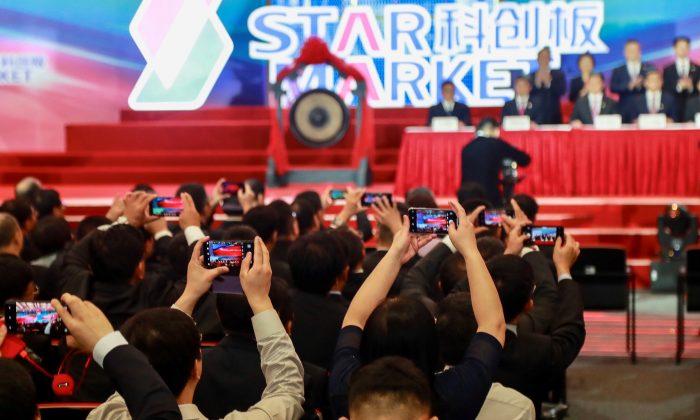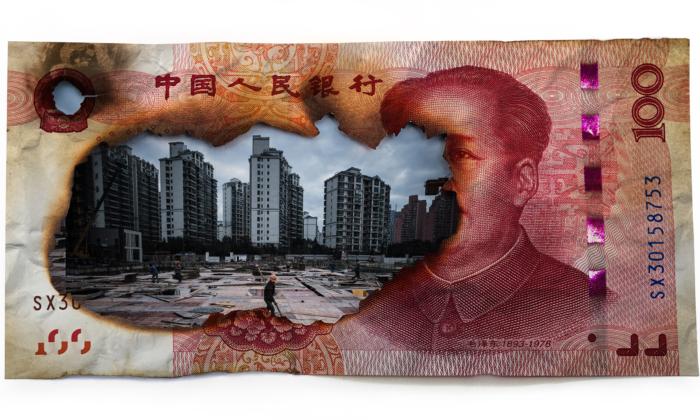China last week debuted another stock exchange—the STAR Board—in a bid to drum up enthusiasm in its equity markets.
The new stock venue was first announced by Chinese Communist Party leader Xi Jinping last year in hopes of attracting domestic businesses, especially technology firms, to list in China, instead of seeking initial public offerings (IPO) abroad. Operated by the Shanghai Stock Exchange, STAR was billed as China’s own “Nasdaq” exchange.
STAR’s debut was a boon for the 25 companies that began trading at the exchange last week. The share prices of all 25 companies soared at their opening on July 22, with average gains of 140 percent at the end of the first day of trading. One of the most high-profile listings on STAR is China Railway Signal & Communication Corp., which also lists shares on the Hong Kong Stock Exchange.
Support from top Beijing officials generated substantial initial enthusiasm among retail investors.
“Gains were much stronger than expected, either due to unreasonable IPO pricing or speculative trading,” Zhu Junchun, an analyst at Lianxun Securities in Shanghai, told Bloomberg on July 22.
But investors lost money as quickly as they made it.
A Different Breed of Stock Market
Beijing hopes STAR will convince the country’s biggest technology firms to list domestically. It’s a little known fact that none of China’s largest, most influential technology firms are listed in China itself and that Chinese investors can’t easily own shares in them. Tencent Holdings and Meituan-Dianping are both listed in Hong Kong. Baidu, JD.com, and Alibaba Group are all listed on Nasdaq in New York.China’s domestic A-shares are dominated by stodgy state-owned banks, oil companies, and industrial firms. Meanwhile, China is home to 94 of the world’s 326 unicorns—or startups with valuations of greater than $1 billion—yet they have very little chance of doing an IPO in China due to stringent listing rules for domestic markets.
STAR is a different type of stock exchange for China. Unlike most other Chinese exchanges, stock movements are uncapped, and companies that haven’t recorded profits can be listed on STAR. In addition, STAR will support shares with unequal voting rights—a hallmark of startups looking to preserve voting control for founders.
In other words, STAR will become the most unfettered, speculative market in China. The country’s stock markets already experience frothy valuations and extreme volatility despite tightly regulated exchanges.
There are some requirements to trade STAR stocks. Investors must have 500,000 yuan (approximately $72,000) to trade on STAR. The Shanghai Stock Exchange also plans to create an index to track the companies on STAR.
In China, Bigger Is Better
Despite the initial frenzy, investors should exercise extreme caution speculating on IPOs of unproven companies listed on STAR.First, we can’t forget that China’s first attempt at creating a technology-supportive exchange failed miserably. The 2009-vintage ChiNext market never took off, due to lack of liquidity and, if we’re to be honest, a lack of good companies to invest in.
Although China is home to some promising startups today, the existing market environment still favors large, established state-owned firms, Chen Li, chief economist at Soochow Securities, recently told the Hong Kong-based newspaper South China Morning Post, which is owned by Alibaba.
Bloomberg data showed that in 2019, the 50 biggest companies on the Shanghai and Shenzhen exchanges on average doubled their performance relative to the Shanghai Composite Index—which takes all securities into consideration.
Exercising Caution
Sentiment in Chinese equities is mixed today, and some leading market strategists are advocating for caution. Chinese equity valuations seem rich at the moment, despite hype generated by STAR.“We do not believe the near-term enthusiasm for STAR trading can meaningfully boost the A-share market overall from the perspective of both sentiment and fundamentals,” Morgan Stanley Asia equity strategist Laura Wang wrote in a research note to clients on July 26.
Pan Yue, CEO and chief investment officer of Jinghong Investment Co., believes the recent high stock turnover rate is an indication of smart money leaving the market. “Of [investment managers’] allotment of their IPO subscription, they sold almost all of them,” Pan told Bloomberg TV on July 23, referring to the unusually high turnover rate seen after STAR’s debut. “And it is confirmed by all the public fund managers, they have sold out a lot.”
“I think at this point I would be more cautious,” Pan said. “Most of the tech stocks have reached their peaks.”
On a more macro level, Japanese brokerage house Nomura Securities believes China and Hong Kong could be due for a financial crisis, according to a Forbes report.
Nomura’s proprietary Cassandra risk-assessment program tracks 60 early-warning indicators for financial risk. Hong Kong has 49 red signals, while China is the second-highest with 25, the report said. Nomura’s models have accurately predicted two-thirds of the past 50 financial crises in a sample of emerging and advanced economies.





